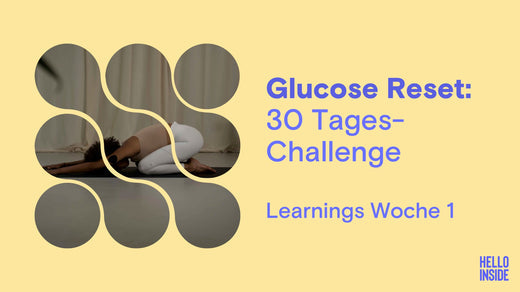The first week of the Hello Inside Challenge is behind us—and what a start it's been! Our participants have shown impressive curiosity and commitment to better understanding their health. In this blog post, we take a look at the most frequently asked questions, surprising insights, and shared experiences of the week.
Right at the start of the challenge, some exciting questions arose:
- How do I correctly interpret the Abbott Freestyle Libre sensor values?
- Why do my glucose levels fluctuate so much?
- What does slightly elevated fasting blood sugar mean?
- How do meals or infections affect my blood sugar?
- Why should I track my diet in the Hello Inside app if I already use another app?
- Why do we recommend personal coaching starting in week 3 or 4 at the earliest?
Especially at the beginning, using the sensor was new to many of us. Questions about calibration, possible time delays in measured values, and the interpretation of peaks (e.g., after meals) were discussed intensively. This demonstrated how valuable the exchange within the group is for our shared journey.
How do I correctly interpret the Abbott Freestyle Libre sensor values?
The sensor displays glucose levels in the tissue fluid under the skin, not directly in the blood. This can result in a delay of about 5-15 minutes. Pay attention to identifying patterns in your readings rather than focusing on individual measurements. Observe trends—how meals, stress, or sleep influence your readings—and use these insights to adjust your habits.
Is it normal for my glucose levels to fluctuate so much?
Your values fluctuate due to factors such as:
-
Diet & Order: High-glycemic foods like white rice, pasta, or juices can lead to rapid spikes. Combining them with fat, protein, or fiber helps mitigate the reaction. The order in which you eat the individual components is crucial: Start with fiber, then all proteins, and finally carbohydrates, and observe the difference!
-
Time of day: Insulin sensitivity is often lower in the morning than in the afternoon, which means that you tend to react more strongly to carbohydrates in the morning.
-
Stress: Hormones like cortisol increase your blood sugar. Relaxation techniques can help if you notice that your blood sugar is significantly higher than usual one day.
Is this already elevated fasting blood sugar in the morning?
Fasting blood sugar between 100-125 mg/dL indicates impaired glucose tolerance. However, this doesn't automatically equate to pre-diabetes: Stress, an infection, or late meals can significantly influence these values. More important than a single measurement are trends over several days, with sufficient sleep and, ideally, without an acute cold or flu.
Why should I track my diet in the Hello Inside app if I already use another app?
We understand that double-tracking may seem cumbersome at first. However, there are clear advantages to tracking your diet directly in the Hello Inside app:
-
Holistic approach: Your blood sugar is influenced by many factors, not just what you eat. Symptoms, exercise, moods, and sleep also play a role. By tracking in a single app, you can combine this information and identify real patterns.
-
A concrete example: Some users reported that a clear broth with egg added caused their blood sugar to spike unexpectedly at night. However, the cause wasn't the food itself, but a concurrent flu. The infection in the body leads to elevated stress hormones, which affect blood sugar levels.
By combining all data points in the Hello Inside app, you can recognize such connections more quickly and classify them better.
Why don't we recommend personal coaching before week 3?
We recommend that you wait until at least week 2, preferably week 4, for personal coaching. Why?
-
Time for pattern recognition: It takes at least two weeks to identify clear trends and connections between your diet, exercise, stress, and blood sugar levels. These insights form the basis for effective coaching.
-
Effective coaching: With a solid understanding, you can use coaching to get targeted tips for change that you might not have recognized on your own.
-
No time pressure: Take your time to familiarize yourself with the sensor and the app. The more you know about your body, the more effective the coaching will be for you.
Amazing insights from meals and individual reactions
A highlight of the week were the meals that had an unexpectedly strong impact on the participants' blood sugar levels. Some foods considered healthy, like fruit on an empty stomach, led to unexpectedly high glucose spikes. Other combinations, such as adding fat or fiber, helped keep levels more stable—a first major learning curve!
For example, consuming whole-grain oatmeal alone causes spikes, while combining it with nuts and yogurt significantly reduces the response. Such findings demonstrate how individual metabolism varies—and how valuable real-time data from the Abbott Freestyle Libre sensor can be.
A joint first step has been taken!
This first week has shown how active and motivated our group is, which we are extremely pleased and motivated by! The journey of discovery has begun, and the insights gained are a valuable step toward a deeper understanding of our own bodies. We look forward to the coming week and to clarifying more exciting questions and celebrating successes!
Sources:
-
WHO. (2020). Definition and Diagnosis of Diabetes Mellitus and Intermediate Hyperglycemia.
-
German Diabetes Society (DDG). (2023). Guidelines for diabetes diagnosis and control.





